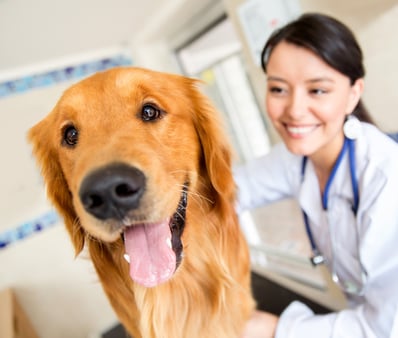How To Become A Physical Therapist For Animals
Just like their human counterparts, animals can develop functional limitations and mobility impairments equally they age. Therefore, animals will also do good from a skillfully developed plan of intendance for rehabilitation to address these issues. An animal rehabilitation therapist is just the person for the chore. Brute rehabilitation is a growing niche field - and then much then that the APTA's Orthopaedic Section has a Special Involvement Group dedicated to it! The Globe Confederation of Physical Therapy as well established a subgroup for PTs in Animate being Practice in 2011. Every bit the field expands, physical therapists accept more and more than opportunities to go involved with animal rehabilitation. The veterinarian customs has long recognized the benefits of physical therapy for animals, just its clinical application and relevance here in the Us is yet in its infancy. Among the primeval recorded pioneers of animal rehabilitation was Sir Charles Stiff, a European neighbor who published a book on Equine Physiotherapy in the mid-1960's. Every bit equine sporting events grew in popularity, and so did associated racehorse injuries. Thus, horses may have been i of the starting time 4-legged species to publicly do good from physical therapy! Past the 1980's, canine rehabilitation was well known in Europe and by the 1990's, the U.South. started to take discover. The first canine rehabilitation certificate program was started before long later on the American Veterinarian Medical Association added "fauna concrete therapy" to its guidelines in 1996. Much similar human being medicine, veterinary medicine is seeing a shift in exercise to more than preventative care versus curative and palliative intendance. In 2003, the Canine Rehabilitation Found, established by veterinarian Dr. Janet Van Dyke, welcomed its first set of students with the vision and foresight to prepare professionals with tools and noesis to care for our animal companions. Similarly, the University of Tennessee established a slew of college education programs for canine and equine rehabilitation. These programs are offered to veterinarians/vet technicians, likewise as PTs/PTAs and OTs/OTAs. As of today, our canine companions have most of the spotlight when it comes to animal rehabilitation. In that location are two places where you can go certified in canine rehabilitation: The Canine Rehabilitation Found (CRI) and the Academy of Tennessee (UoT). At CRI, you will be working towards the Canine Rehabilitation Therapist Certification (CCRT) and you must have your concrete therapy license to qualify for enrollment. At UoT, the Canine Rehabilitation Document Programme (CCRP) is offered to both PTs, PTAs, and students of those disciplines. UoT also has certification programs for equine rehabilitation, equine taping, canine fitness preparation, canine osteoarthritis case direction, canine pain management, and nutrition case direction. Both centers have been canonical by the American Association of Veterinary State Boards Registry of Approved Continuing Educational activity. Both the CRI and UoT websites offering fairly comprehensive descriptions of the length and cost of their courses, but here's a table for a quick comparison: Most animal rehabilitation therapists work alongside veterinarians and veterinary technicians in a clinic-based setting. To gain more knowledge most the life of an animal PT, I went straight to the source and interviewed Francisco Maia, PT, DPT, CCRT, also known every bit TheK9PT. Francisco earned his certification in 2015 and has been working full-time since then as a Chicago-based canine therapist. He has created a fantastic website detailing the ins and outs of what it'due south like to work with our canine friends on a daily basis. Francisco too offered some applied insights for those interested in pursuing canine rehab: To further connect with Francisco, y'all tin visit his public pages: Well, that'due south the exciting part. Information technology can begin with YOU! Canine and equine physical therapy are just the beginning of brute rehab. Don't hesitate to further the conversation and build your own realm of expertise with a group of similar-minded individuals! For now, it seems that getting certified in canine rehabilitation is a good identify to start. However, there are countless animal populations that would reap many benefits from rehab (take you seen the turtle on wheelies still?). Plenty of therapists accept farther applied their canine rehab knowledge to treat our similarly aging and/or post-surgical feline friends. Additionally, animals like bunnies will have conditions like torticollis and splay leg. Other special-needs animals may have neurological impairments or may require limb amputations. The opportunities within animal rehabilitation are countless. Become after your animal rehab passions and ameliorate the lives of our earth-sharing companions! Are y'all an animal rehabilitation therapist or are y'all interested in seeing the field develop? Annotate below and share your story. We would honey to hear from you lot. APTA: Orthopaedic Section SIG Animate being Rehabilitation Canine Rehabilitation Institute:http://www.caninerehabinstitute.com/ Today'south Veterinarian Technician: http://todaysveterinarytechnician.com/articles/feline-physical-rehabilitation/ The Academy of Tennessee:http://www.utvetce.com/ World Confederation of Physical Therapy:PTs in Animal Practice

Yous chose concrete therapy over vet schoolhouse, but yous love animals still?
How did animal rehabilitation beginning?
How do you get an animal rehabilitation therapist?
What'due south information technology like being a canine PT?
Want to find out more? Bank check out The Ultimate Guide to Canine Rehabilitation by Francisco Maia!

Website:https://thek9pt.com/
Facebook:https://www.facebook.com/theK9PT/
Instagram:https://www.instagram.com/thek9pt/ Though I love canines, what about our other animal friends?
References
Source: https://www.coremedicalgroup.com/blog/animal-rehabilitation-therapist
Posted by: lockhartthereenewhe.blogspot.com

0 Response to "How To Become A Physical Therapist For Animals"
Post a Comment